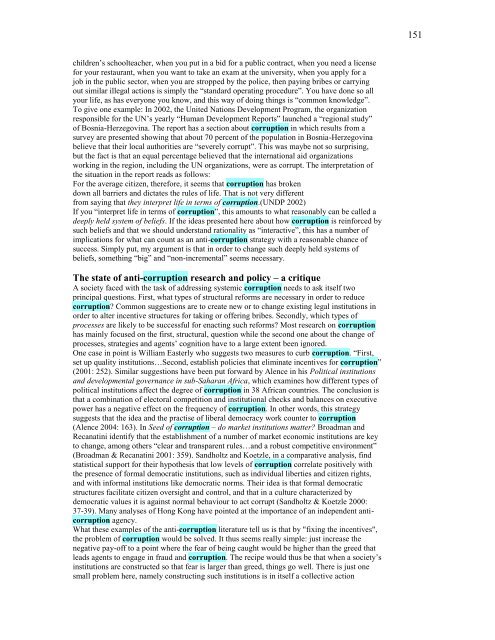FILSAFAT KORUPSI - Direktori File UPI
FILSAFAT KORUPSI - Direktori File UPI
FILSAFAT KORUPSI - Direktori File UPI
You also want an ePaper? Increase the reach of your titles
YUMPU automatically turns print PDFs into web optimized ePapers that Google loves.
children‘s schoolteacher, when you put in a bid for a public contract, when you need a license<br />
for your restaurant, when you want to take an exam at the university, when you apply for a<br />
job in the public sector, when you are stropped by the police, then paying bribes or carrying<br />
out similar illegal actions is simply the ―standard operating procedure‖. You have done so all<br />
your life, as has everyone you know, and this way of doing things is ―common knowledge‖.<br />
To give one example: In 2002, the United Nations Development Program, the organization<br />
responsible for the UN‘s yearly ―Human Development Reports‖ launched a ―regional study‖<br />
of Bosnia-Herzegovina. The report has a section about corruption in which results from a<br />
survey are presented showing that about 70 percent of the population in Bosnia-Herzegovina<br />
believe that their local authorities are ―severely corrupt‖. This was maybe not so surprising,<br />
but the fact is that an equal percentage believed that the international aid organizations<br />
working in the region, including the UN organizations, were as corrupt. The interpretation of<br />
the situation in the report reads as follows:<br />
For the average citizen, therefore, it seems that corruption has broken<br />
down all barriers and dictates the rules of life. That is not very different<br />
from saying that they interpret life in terms of corruption.(UNDP 2002)<br />
If you ―interpret life in terms of corruption‖, this amounts to what reasonably can be called a<br />
deeply held system of beliefs. If the ideas presented here about how corruption is reinforced by<br />
such beliefs and that we should understand rationality as ―interactive‖, this has a number of<br />
implications for what can count as an anti-corruption strategy with a reasonable chance of<br />
success. Simply put, my argument is that in order to change such deeply held systems of<br />
beliefs, something ―big‖ and ―non-incremental‖ seems necessary.<br />
The state of anti-corruption research and policy – a critique<br />
A society faced with the task of addressing systemic corruption needs to ask itself two<br />
principal questions. First, what types of structural reforms are necessary in order to reduce<br />
corruption? Common suggestions are to create new or to change existing legal institutions in<br />
order to alter incentive structures for taking or offering bribes. Secondly, which types of<br />
processes are likely to be successful for enacting such reforms? Most research on corruption<br />
has mainly focused on the first, structural, question while the second one about the change of<br />
processes, strategies and agents‘ cognition have to a large extent been ignored.<br />
One case in point is William Easterly who suggests two measures to curb corruption. ―First,<br />
set up quality institutions…Second, establish policies that eliminate incentives for corruption‖<br />
(2001: 252). Similar suggestions have been put forward by Alence in his Political institutions<br />
and developmental governance in sub-Saharan Africa, which examines how different types of<br />
political institutions affect the degree of corruption in 38 African countries. The conclusion is<br />
that a combination of electoral competition and institutional checks and balances on executive<br />
power has a negative effect on the frequency of corruption. In other words, this strategy<br />
suggests that the idea and the practise of liberal democracy work counter to corruption<br />
(Alence 2004: 163). In Seed of corruption – do market institutions matter? Broadman and<br />
Recanatini identify that the establishment of a number of market economic institutions are key<br />
to change, among others ―clear and transparent rules…and a robust competitive environment‖<br />
(Broadman & Recanatini 2001: 359). Sandholtz and Koetzle, in a comparative analysis, find<br />
statistical support for their hypothesis that low levels of corruption correlate positively with<br />
the presence of formal democratic institutions, such as individual liberties and citizen rights,<br />
and with informal institutions like democratic norms. Their idea is that formal democratic<br />
structures facilitate citizen oversight and control, and that in a culture characterized by<br />
democratic values it is against normal behaviour to act corrupt (Sandholtz & Koetzle 2000:<br />
37-39). Many analyses of Hong Kong have pointed at the importance of an independent anti-<br />
corruption agency.<br />
What these examples of the anti-corruption literature tell us is that by "fixing the incentives",<br />
the problem of corruption would be solved. It thus seems really simple: just increase the<br />
negative pay-off to a point where the fear of being caught would be higher than the greed that<br />
leads agents to engage in fraud and corruption. The recipe would thus be that when a society‘s<br />
institutions are constructed so that fear is larger than greed, things go well. There is just one<br />
small problem here, namely constructing such institutions is in itself a collective action<br />
151

















